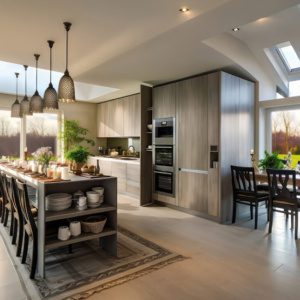When designing a room, furniture selection plays a crucial role in shaping both style and functionality. In fact, room furniture design goes beyond just picking out pieces you like; it’s about creating a harmonious space that feels inviting and serves your needs. Here’s how to elevate your room with well-thought-out furniture design choices.

1. Define the Purpose of the Room
First and foremost, consider the room’s primary function. For instance, a living room may require ample seating and storage, while a home office should focus on ergonomic and productive setups. By listing key activities for each room, you can better understand what type of furniture is essential to meet those needs.
2. Consider Scale and Proportion
Next, think about the size of each piece in relation to the room itself. Too-large furniture can make a space feel cramped, while too-small items may leave it looking sparse. Therefore, be sure to measure accurately, noting doorways, windows, and other architectural features. This way, you’ll ensure each piece fits well, creating a layout that feels spacious and accessible.
3. Balance Comfort with Functionality
Although aesthetics are important, comfort and usability are equally crucial. In family rooms, for example, sofas with supportive cushions and easy-to-clean fabrics work best. Similarly, in a bedroom, consider adding a bed with built-in storage for extra functionality. So, think carefully about how each piece supports your lifestyle and daily routines.
4. Incorporate Color and Texture for Depth
Additionally, colors and textures can transform the atmosphere of any room. Light-colored furniture often makes smaller spaces feel more open, whereas darker tones add warmth. By mixing materials like wood, metal, and fabric, you’ll create a visually interesting space that feels layered and cohesive.
5. Balance Style with Practicality
While it’s tempting to choose pieces purely for their looks, think about durability too. For example, if you have kids or pets, opt for stain-resistant fabrics or tougher materials like leather. If you want a modern aesthetic, sleek furniture with clean lines is ideal, but for a classic feel, consider timeless pieces in rich wood finishes.
6. Establish a Focal Point
Creating a focal point is a smart way to anchor the room. This could be a statement sofa, a unique coffee table, or even a striking piece of art. By arranging furniture around this focal point, you’ll naturally guide the eye and create a balanced, visually appealing design.
7. Express Personality with Accents
Adding accents like throw pillows, artwork, and rugs can help personalize your space. These accessories are easier to update with trends or seasonal changes, allowing the room to stay fresh without major adjustments. Moreover, mixing patterns, colors, and textures adds character and dimension to your design.
8. Think About Flow and Movement
Finally, a well-designed room should encourage easy movement. Arrange furniture with natural walking paths in mind to keep the room from feeling cluttered. For larger spaces, you can break up the room into zones by using area rugs or strategically placed pieces, creating distinct areas for different activities.
Conclusion
Designing a room with the right furniture requires attention to detail and a balance of beauty and functionality. By considering the room’s purpose, layout, and size, and choosing pieces that meet both your practical and aesthetic needs, you can transform any space into a welcoming and functional area. Embrace these tips, and let your room furniture design become a true reflection of your personal style and lifestyle.
